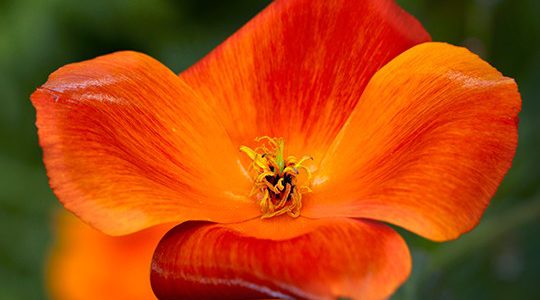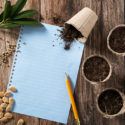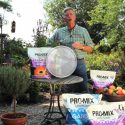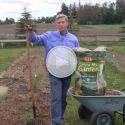My goal is to provide as compelling an argument as I can for you to invest in the future of your garden this spring – indeed the future of the planet as we know it – by consciously planting ‘pollinator plants’.
What is a pollinating plant?
Most plants generate pollen: it is the elixir of plant life, unless you are a fern or a mushroom which reproduce by spores. But that is another story. The pollen produced on a male anther is transferred to the female stigma on a flower to create fertilization of the ovaries where a seed is produced. It is this seed that holds the key to the next generation of plant life. Without pollen, no fertilization, no seed. And without the seed there are no baby plants. The purpose of designing a landscape that attracts pollinators is to assist Mother Nature in her ongoing efforts to create biodiversity and the regeneration of plant life. The more plants in your garden that attract pollinating insects, birds, butterflies, moths, and other such creatures, the healthier your garden will be overall. You are not running a plant hospital after all, so it behooves the gardener to ensure that his garden is as strong and healthy as possible. The results can be stunning. More flowers, fruit (vegetables), and a better looking garden will result over time. Before planting, I always recommend amending the existing garden soil. Add a generous layer of PREMIER® BIO-MAX® fully composted manure. CQA certified meeting the guidelines of the Compost Quality Alliance. Add nutrients and improve the structure of your garden with the safer alternative that meets the highest quality standards.
Here is a short list of my favourite pollinating plants, listed by flowering season:
Early-Blooming Pollinator Plants:
California poppy – plant from seed for best results. Direct sow on well-prepared soil and do not disturb or cover the seed. Water gently for a magnificent show of colour come June and early July. Sunny locations only. Larkspur. I use transplants for the most reliable show. This popular biannual will produce tall panicles of bright-coloured blossoms similar in shape to a delphinium only smaller. Remove the first few flowers after they bloom to encourage later season blossoms then let the latter blossoms go to seed naturally in your garden where young seedlings will present themselves this fall and next spring. Sunny to partly sunny locations. Chives. Grow from seed or transplants: you cannot stop chives from growing and reproducing all over your yard. Let them flower for a sweetly scented herb that attracts native bees and non-native honey bees in droves. Note that all parts of the chive plant are edible so you can go nuts in the kitchen with this one. Keep the breath mints handy though. Violas. While shopping for early-flowering, frost-resistant pansies, be sure to pick up some of their smaller flowering cousins. Violas are sweetly fragrant, tougher than pansies and most varieties reproduce in the garden all by themselves much more readily than do pansies. Well, not exactly all by themselves as they need the pollinators to make the reproduction happen, which was my original point. Sun to part shade.
Mid-Season Pollinator Plants:
Basil. Another herb that attracts a wide range of pollinating insects. Basil can be grown easily from seed indoors or small plants purchased from your retailer work equally well. They are frost sensitive so do not plant them out until late May. Basil is a heat-seeker so plant in a bright, sunny location and allow the plant to flower if you wish to attract pollinators. However, removing the flowers will encourage more foliage growth. I allow my basil to go to seed late in the summer. Calendula. So easy to grow from seed! I have sown mine directly in the garden already. They are marginally hardy to frost, love the sun, produce the most vividly hot shades of orange and yellow that you can imagine. I grow a row of them in my vegetable garden for the pollinators, the show, and to cut and bring indoors from late July onwards. Sun lovers. Monarda. Here is a reliably hardy perennial that will spread through your garden unless you aggressively remove unwanted portions of the plant each spring. However, it flowers for up to 6 weeks with gorgeous red/rose or white blooms. Plant transplants for instant results or sow seeds directly into the garden soil. Needs a minimum of 6 hours of sun. Bees and hummingbirds are attracted to monarda like a magnet.
Later-Blooming Pollinator Plants:
Agastache or Russian Sage. A strong growing perennial that puts on quite a show of blue/purple blossoms for up to 6 weeks. It is true, bees love it. A good cut flower for mixed arrangements in August and September. Plant store bought transplants this time of year. Sun. Sunflowers. Do you have kids? If not, can you borrow some from a neighbour? It is a shame to sow sunflowers alone when there are children around who will benefit from the action. Nothing germinates from seed faster, grows taller, provides more drama with their wide-faced sunny blossoms and attract honey bees and native bees as well. Make sure that you sow sunflowers in a sunny position; soil prepared with dug–in PREMIER® BIO-MAX® Compost or Composted Manure and be sure to water until they become established after the first 4 weeks or so. Also, consider how you will support them come midsummer if they are exposed to high winds. Feed your flowering plants with Plant-Prod® Flowering Plant Fertilizer 15-30-15. This formulation should be used from the early stages of flower bud development through flowering when demand for phosphorous is high in the plant.
#1 Job
The most important thing to remember is this: from the point of view of a plant, the #1 job they have is to become pollinated in order to reproduce. It is nice to think that flowers were put here for our enjoyment, but that notion is arrogant and wrong. Once we understand that the universe does not revolve us but rather is a complex of interdependent cooperators: insects, birds, and flowers assisting one another in their efforts to survive, reproduce, and thrive, we will have learned one of the most important and basic lessons of life.
Suggested Products
-
No suggested products found.



